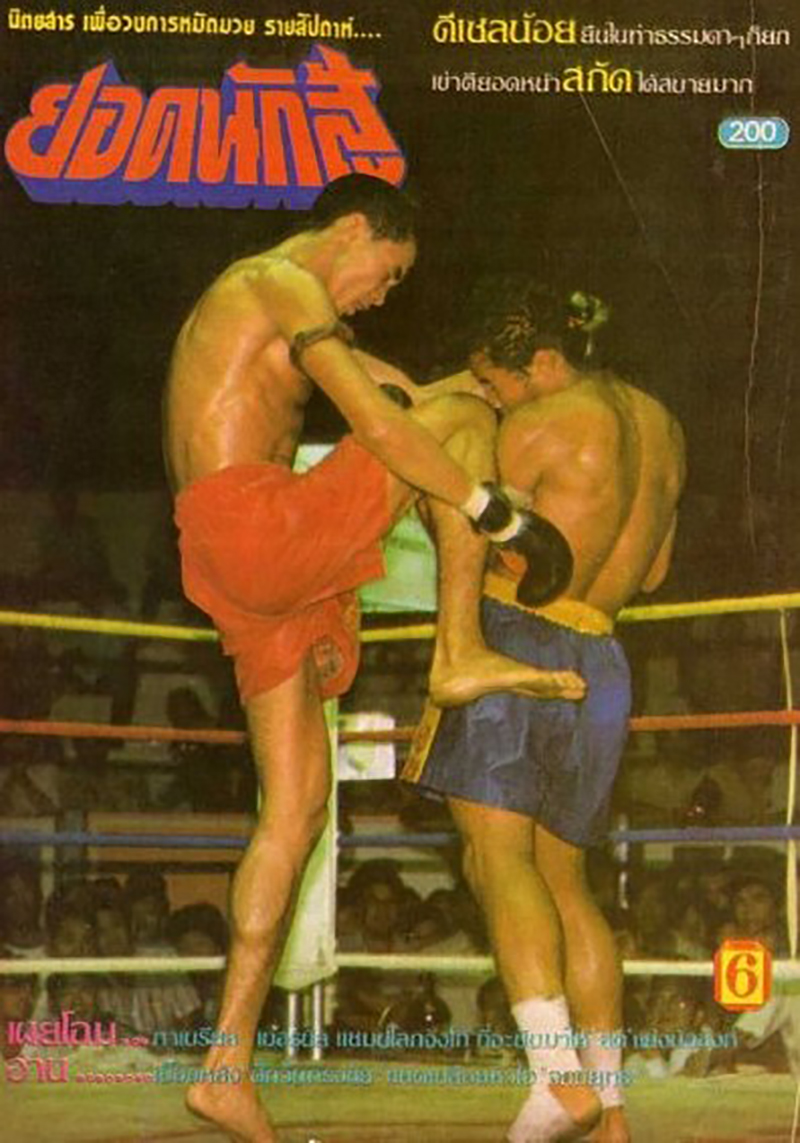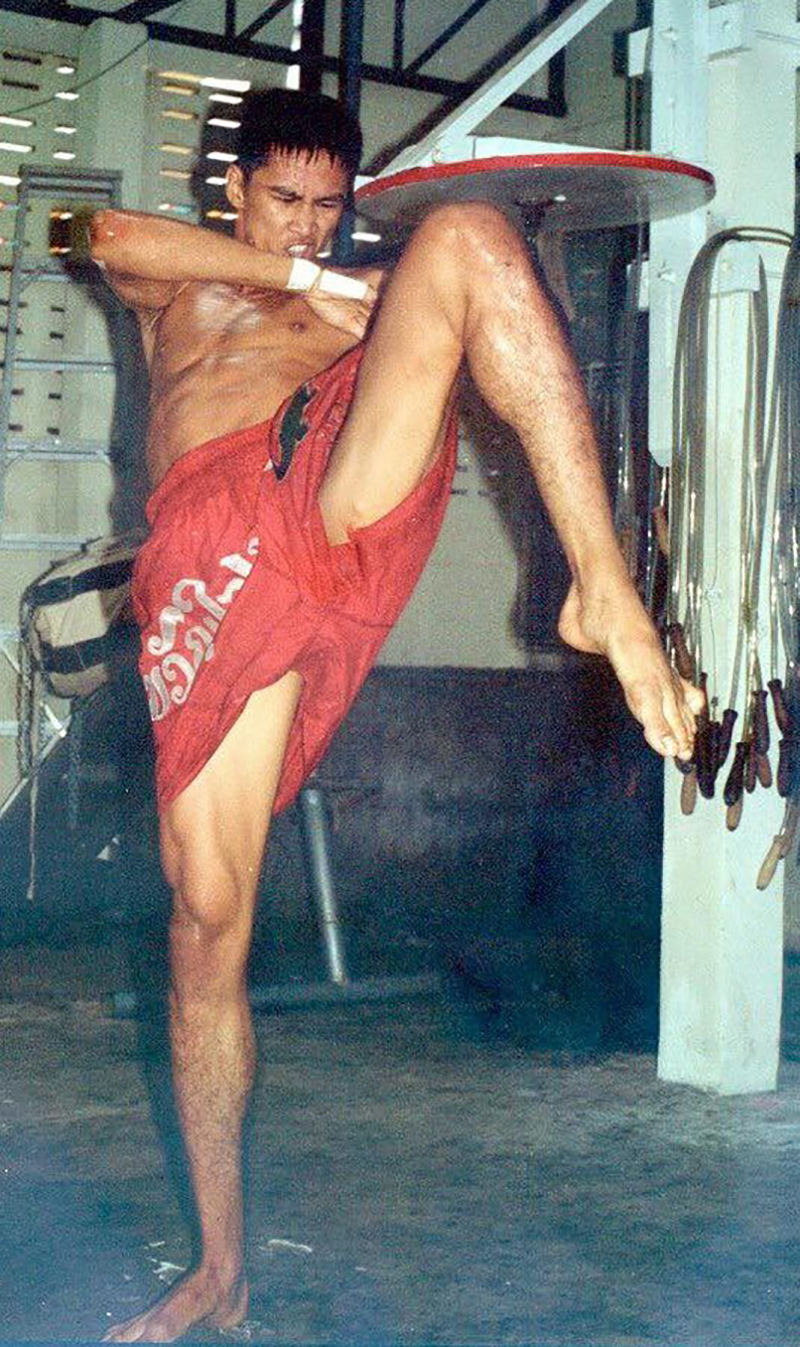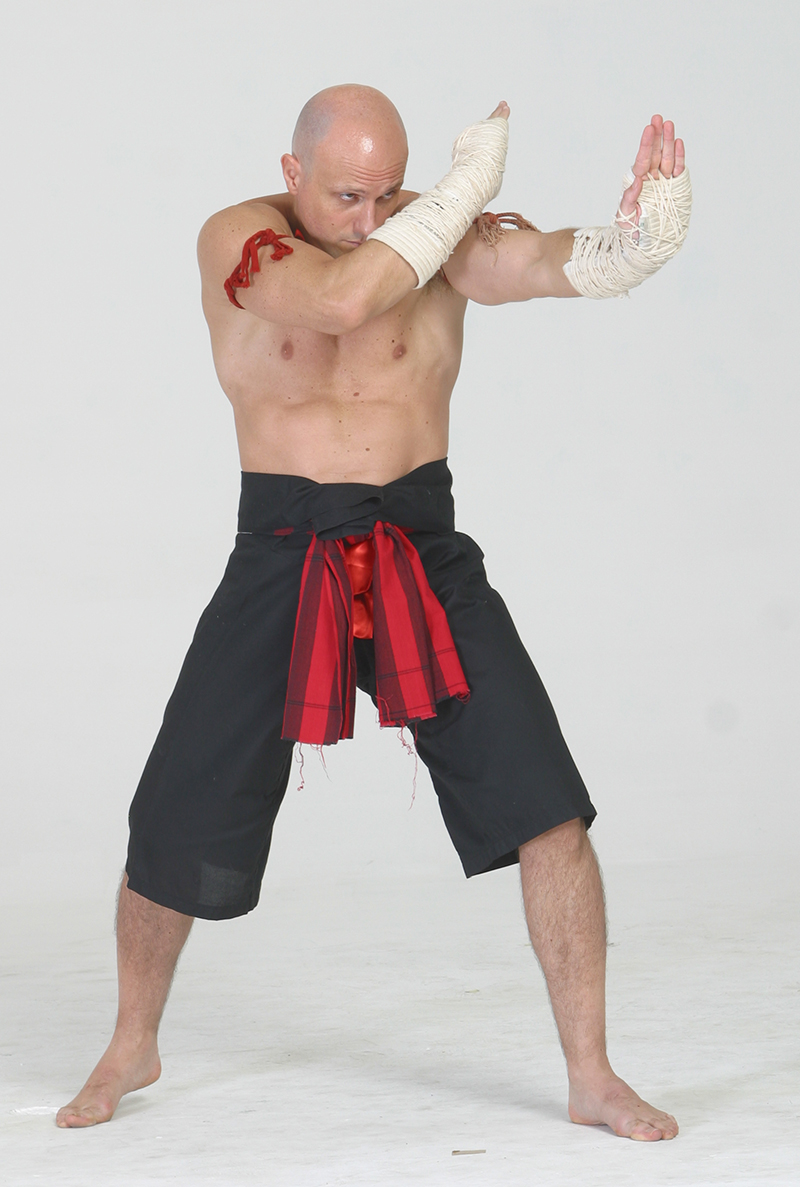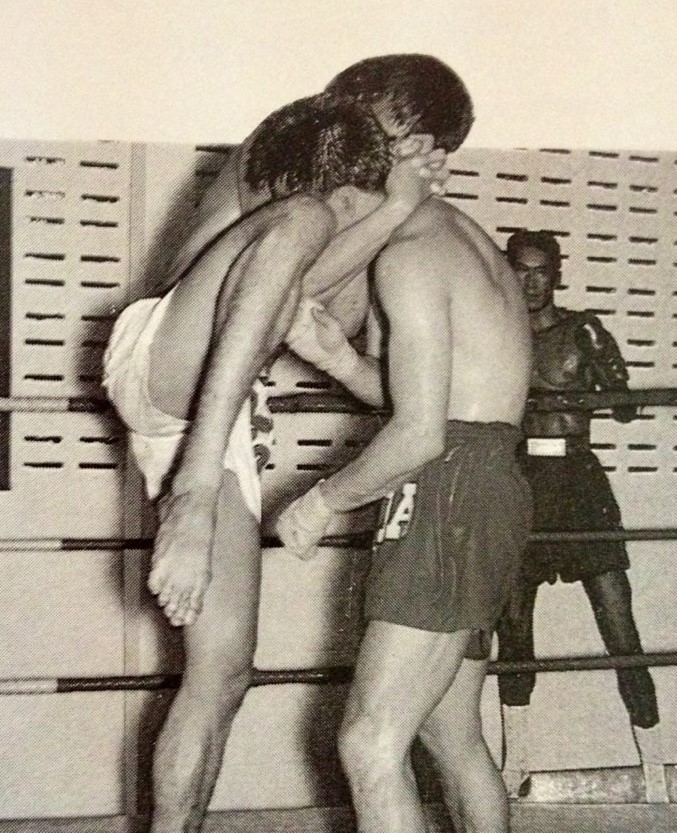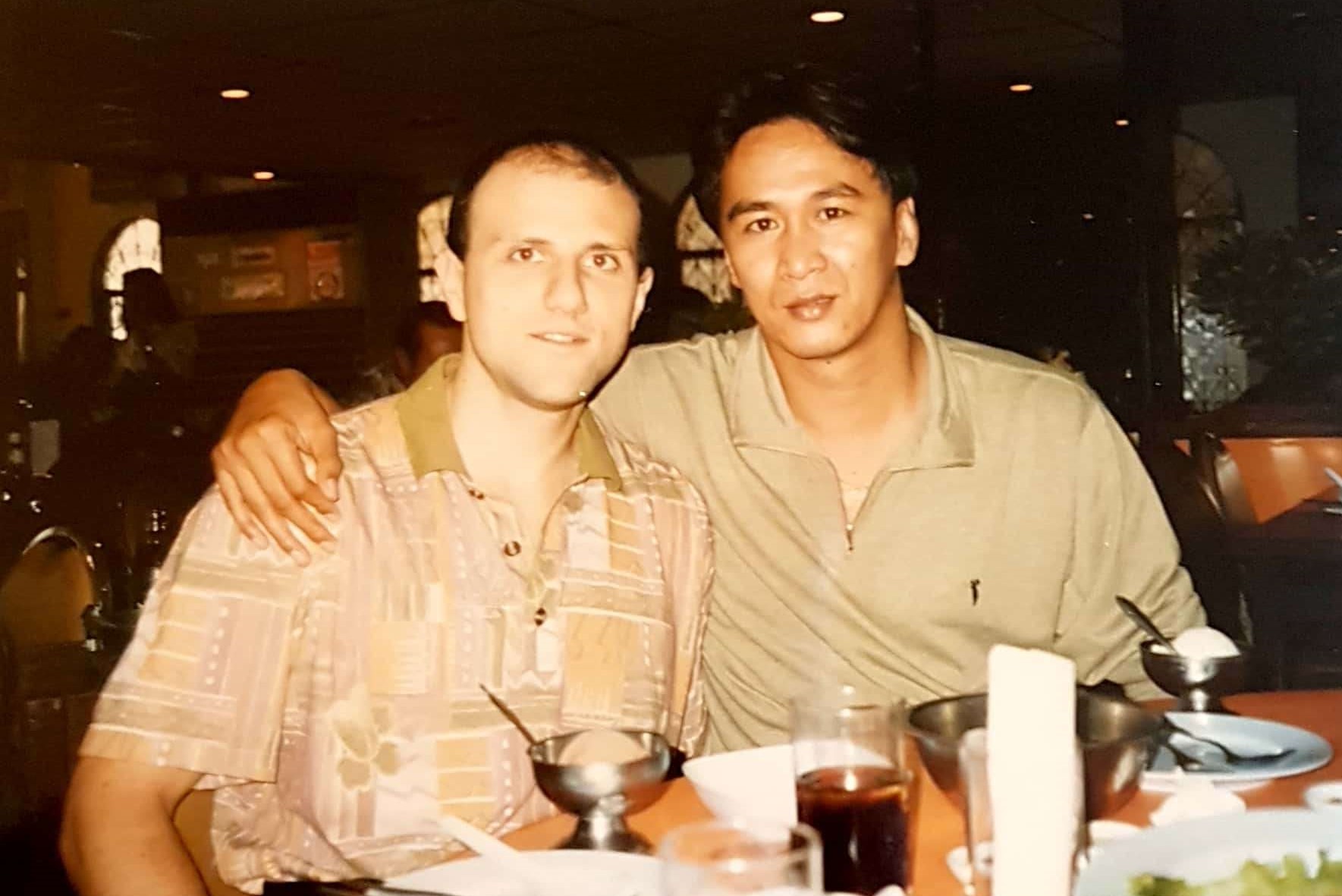
Diesel Noi Chor Thanasukarn, master of Muay Kao.
By Marco De Cesaris
I met Diesel Noi Chor Thanasukarn in 1991(6 years after his official retirement). My Muay Thai teacher Khru Chokechaichana Krutsuwan and a French friend of mine monsieur Kuider Abdelmoumeni (former European Muay Thai Champion and International Referee, at the time) insisted that it would be very important for my technical growth to meet the man they considered the greatest Knee Specialist of all time.
Diesel Noi was without any doubt, one of the most famous thai boxers of the last decades, ranked amongst the 10 best fighters of all time by Ranjadamnern Stadium. His real name is Charin Sorndee, but he was widely known with the boxing name of Diesel Noi Chor Thanasukarn. He reigned between the second half of the ‘70 and the first half of the ‘80 as the best pound for pound boxer in Thailand (undisputed Lumpini Stadium title holder in 1981and Fighter of the Year in 1982). He made a name for himself by beating very strong opponents, among them some of the best fighters of his time: Sagat Petchyndee, Samart Payakaroon, Krongsak Boranrat, just to name a few.
My Muay Thai teacher and my French friend brought me to meet the Champ and in my heart I still thank them for giving me the chance to meet an exceptional individual, both as a thai boxer and as a human being.
During our two meetings he was extremely friendly, we talked about his career and obviously about his trademark techniques, namely his unique way to apply the traditional “breaking the elephant’s neck” strategy to professional Muay Thai.
His words impressed me and since then, with the help of my Muay Thai teacher, I concentrated in learning all the nuances of Muay Kao, the skill of using knees and grappling holds to annihilate opponents in the boxing ring.
Diesel Noi is an impressive specimen; at less than 60 kg. of weight, his size (188cm ) enabled him to carry out devastating knee strikes, aimed not only at the body (as most thai boxers do) but also at the head of the opponents, most of the times leading to dramatic Knockouts.
His trademark technique, the Muay Thai straight knee kick ,was executed while holding the opponent by the neck or arms. In order to apply these holds and his deadly blows, he had developed several effective strategies to close the gap, seize the opponent and break his balance. These strategies are derived from the ancestral principles of Thai Traditional Grappling (Muay Pram Boran) smartly applied to professional Muay Thai.
The peculiar technical features of Diesel Noi’s Muay Kao are the following:
1. Guard position with outstretched arms
2. Entry techniques
a) Striking to Neck Clinch
b) Stepping forward to Neck Clinch
3. Strategies of striking in the clinch (Chap Ko Ti Kao)
a) Knees to body followed by Knee to head
b) Pivot followed by Knee strike to head
Let’s analyse these features in details.
1.Diesel Noi’s guard position with outstretched arms. In order to intercept the opponent’s attempted punches and at the same time grab him by the arms or neck, the boxing’s basic guard position is not the best option. With your arms outstretched towards the opponent, palms facing forward, you create a shield with your hands and forearms that can easily block the hand attacks aimed at the head. At the same time, the distance that separates your tools (hands and arms) from the target (the opponent’s arms or head) is drastically reduced. It must be understood that this kind of guard position should not be used by a fighter who builds his fighting strategy around punches: the outstreched arms reduce by far the possibility to throw powerful punches and thus its use should be carefully avoided by expert punchers.
2.Diesel Noi’s Muay Kao strategy was based on clever entry techniques that enabled him to quickly and safely close the gap with the opponent and seize him. The two basic entry techniques he commonly employed are part of the Technical Syllabus of IMBA Muay Pram that all IMBA members learn from day one of their training. These techniques are the following:
a.Striking to establish the Neck Clinch
This is the best way for a Muay Thai grappler to “camouflage” his entry into the neck clinch. Diesel Noi often employed a shin kick to the midsection to help him establish a subsequent neck clinch. The middle roundhouse kick forced the opponent to stop in his tracks and this gave our Champion the chance to grab him with his long arms and start unleashing hard knee blows.
Long hours of specific training are needed in order to become proficient at applying this seemingly easy strategy against a live opponent who is doing his best to avoid being cornered and seized.
b.Stepping forward to establish the Neck Clinch
This second option involves various types of footwork aimed at quickly putting the knee specialist at the right distance to start using his chosen body weapon to attack. This kind of aggressive footwork is employed from a middle range: when the opponent is at a greater distance, the first option (striking first and then grabbing) is always preferred. Usually, the aggressive steps can follow a straight forward path or an offensive-evasive pattern. The latter encompasses diagonal forward steps or circular steps. Once the gap has been closed, a barrage of knee strikes must be started immediately. This must be done to prevent the opponent from counter striking or putting in place any defensive strategy.
3.Once the neck hold is established, the knee specialist must quickly start “working”. In a few words, when you get hold of the opponent’s neck, waste no time and either break his balance or start throwing knee strikes to the body, arms or legs. Diesel Noi, used a couple of strategies to keep the opponent busy and prepare him for the finishing knee blow to the head that most of the times put him down. The general strategy of striking in the clinch is called Chap Ko Ti Kao (grab the neck and throw the knees). The best target for your knee strikes is clearly the opponent’s head: however, it is very difficult to directly attack the head of a good thai boxer with a neck grab and head knee strike. Therefore, as the great Diesel Noi showed the world in many occasion, it is much wiser to prepare your final attack to the head with other knee blows or with unbalances. Here are two examples of this strategy.
a.Knees strikes to the body to finishing Knee blow to the head.
First attack the floating ribs, the abdomen or the solar plexus with short, snappy knee strikes. The goal is to bring the opponent’s attention to his midsection, hopefully opening some gaps in his defense of the high target. This strategy can be compared to a boxer who attacks the body in order to force the opponent to lower his guard opening big gaps in his defense of the chin and jaw. Many a times, a few hard body blows by your knees are all you need to open the way to a devastating knee strike aimed at the chin or face of your opponent. A dramatic knock out is surely around the corner.
b.Pivot to knee strike to the head.
The common way to train the neck clinch is the so called “knee sparring”. In working this kind of clinch, most fighters concentrate on forcing the partner’s neck to bend forward, breaking his balance and ideally exposing the chin and face to a possible knee attack. In reality, doing this in the heat of a professional Muay Thai fight, is physically exhausting not only for the opponent but for the executor of the neck hold, as well. The more sophisticated way to bend the neck from the clinch involves an outside circular step, commonly known in Muay Thai circles as Salab Fan Pla.
As a result the opponent’s neck is twisted (Bid Ko in Muay Thai jargon) and his posture completely broken. The combination of the double neck tie, the neck twist and the outside step brings a double effect: it breaks the opponent’s balance with great efficiency (without tiring the executor’s arm muscles) and puts the opponent’s side of the head in a very dangerous position, exposing vital targets such as the temples. A straight knee to the head is a logical consequence. Diesel Noi was very good at applying this sophisticated close range maneuver and many of his ring foes can attest that.
For more information about the traditional Thai Art of Grappling please refer to the official IMBA Muay Pram text-book.


